Hyundai Tucson 2019 Owner's Manual - RHD (UK, Australia)
Manufacturer: HYUNDAI, Model Year: 2019, Model line: Tucson, Model: Hyundai Tucson 2019Pages: 685, PDF Size: 17.76 MB
Page 351 of 685
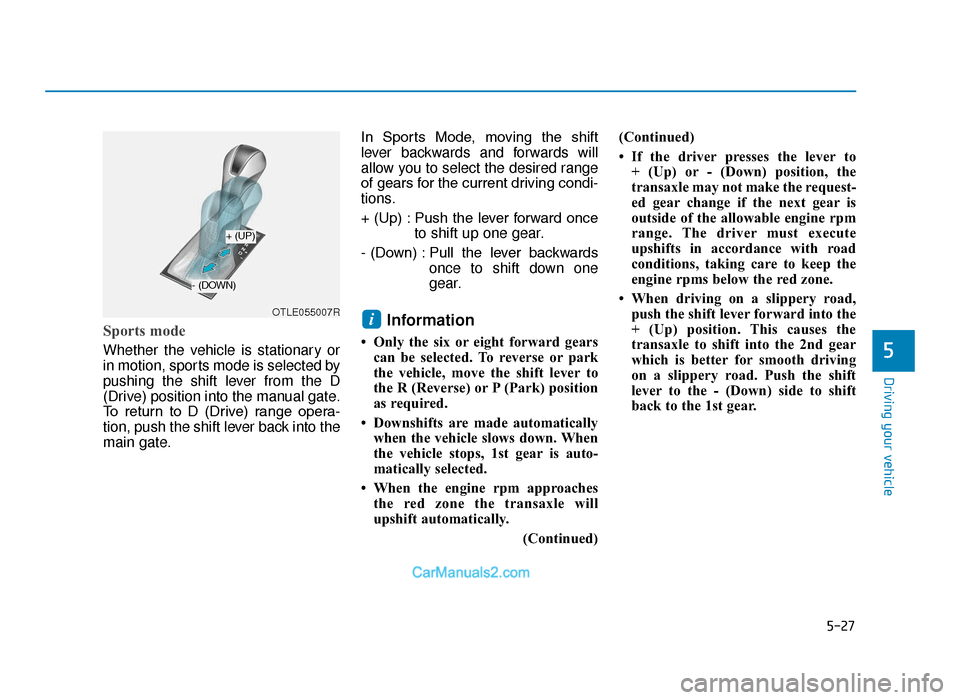
5-27
Driving your vehicle
5
Sports mode
Whether the vehicle is stationary or
in motion, sports mode is selected by
pushing the shift lever from the D
(Drive) position into the manual gate.
To return to D (Drive) range opera-
tion, push the shift lever back into the
main gate.In Sports Mode, moving the shift
lever backwards and forwards will
allow you to select the desired range
of gears for the current driving condi-
tions.
+ (Up) : Push the lever forward once
to shift up one gear.
- (Down) : Pull the lever backwards once to shift down one
gear.
Information
• Only the six or eight forward gearscan be selected. To reverse or park
the vehicle, move the shift lever to
the R (Reverse) or P (Park) position
as required.
• Downshifts are made automatically when the vehicle slows down. When
the vehicle stops, 1st gear is auto-
matically selected.
• When the engine rpm approaches the red zone the transaxle will
upshift automatically.
(Continued)(Continued)
• If the driver presses the lever to
+ (Up) or - (Down) position, the
transaxle may not make the request-
ed gear change if the next gear is
outside of the allowable engine rpm
range. The driver must execute
upshifts in accordance with road
conditions, taking care to keep the
engine rpms below the red zone.
• When driving on a slippery road, push the shift lever forward into the
+ (Up) position. This causes the
transaxle to shift into the 2nd gear
which is better for smooth driving
on a slippery road. Push the shift
lever to the - (Down) side to shift
back to the 1st gear.
iOTLE055007R
+ (UP)
- (DOWN)
TLe UK 5.qxp 5/10/2018 12:20 PM Page 27
Page 352 of 685
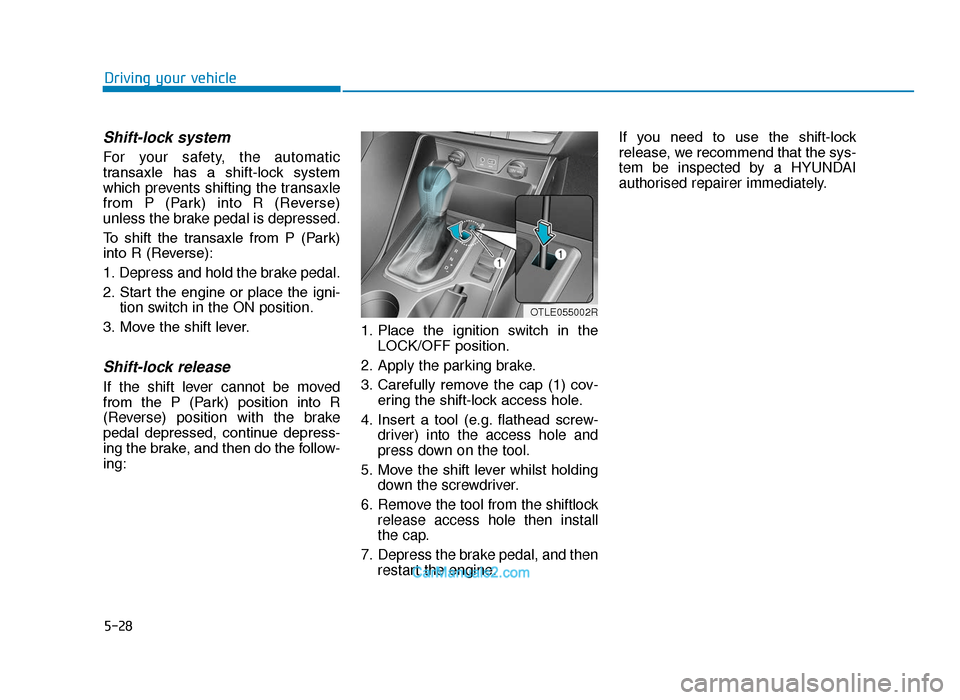
5-28
Driving your vehicle
Shift-lock system
For your safety, the automatic
transaxle has a shift-lock system
which prevents shifting the transaxle
from P (Park) into R (Reverse)
unless the brake pedal is depressed.
To shift the transaxle from P (Park)
into R (Reverse):
1. Depress and hold the brake pedal.
2. Start the engine or place the igni-tion switch in the ON position.
3. Move the shift lever.
Shift-lock release
If the shift lever cannot be moved
from the P (Park) position into R
(Reverse) position with the brake
pedal depressed, continue depress-
ing the brake, and then do the follow-
ing: 1. Place the ignition switch in the
LOCK/OFF position.
2. Apply the parking brake.
3. Carefully remove the cap (1) cov- ering the shift-lock access hole.
4. Insert a tool (e.g. flathead screw- driver) into the access hole and
press down on the tool.
5. Move the shift lever whilst holding down the screwdriver.
6. Remove the tool from the shiftlock release access hole then install
the cap.
7. Depress the brake pedal, and then restart the engine. If you need to use the shift-lock
release, we recommend that the sys-
tem be inspected by a HYUNDAI
authorised repairer immediately.
OTLE055002R
TLe UK 5.qxp 5/10/2018 12:20 PM Page 28
Page 353 of 685
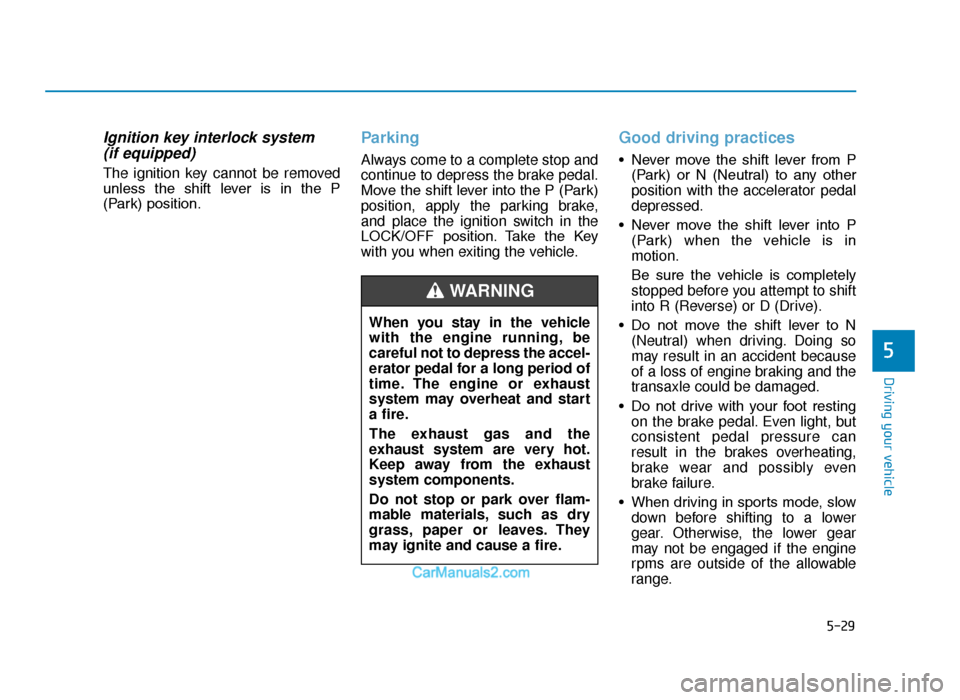
5-29
Driving your vehicle
5
Ignition key interlock system (if equipped)
The ignition key cannot be removed
unless the shift lever is in the P
(Park) position.
Parking
Always come to a complete stop and
continue to depress the brake pedal.
Move the shift lever into the P (Park)
position, apply the parking brake,
and place the ignition switch in the
LOCK/OFF position. Take the Key
with you when exiting the vehicle.
Good driving practices
• Never move the shift lever from P
(Park) or N (Neutral) to any other
position with the accelerator pedal
depressed.
• Never move the shift lever into P (Park) when the vehicle is in
motion.
Be sure the vehicle is completely
stopped before you attempt to shift
into R (Reverse) or D (Drive).
• Do not move the shift lever to N (Neutral) when driving. Doing so
may result in an accident because
of a loss of engine braking and the
transaxle could be damaged.
• Do not drive with your foot resting on the brake pedal. Even light, but
consistent pedal pressure can
result in the brakes overheating,
brake wear and possibly even
brake failure.
• When driving in sports mode, slow down before shifting to a lower
gear. Otherwise, the lower gear
may not be engaged if the engine
rpms are outside of the allowable
range.
When you stay in the vehicle
with the engine running, be
careful not to depress the accel-
erator pedal for a long period of
time. The engine or exhaust
system may overheat and start
a fire.
The exhaust gas and the
exhaust system are very hot.
Keep away from the exhaust
system components.
Do not stop or park over flam-
mable materials, such as dry
grass, paper or leaves. They
may ignite and cause a fire.
WARNING
TLe UK 5.qxp 5/10/2018 12:20 PM Page 29
Page 354 of 685
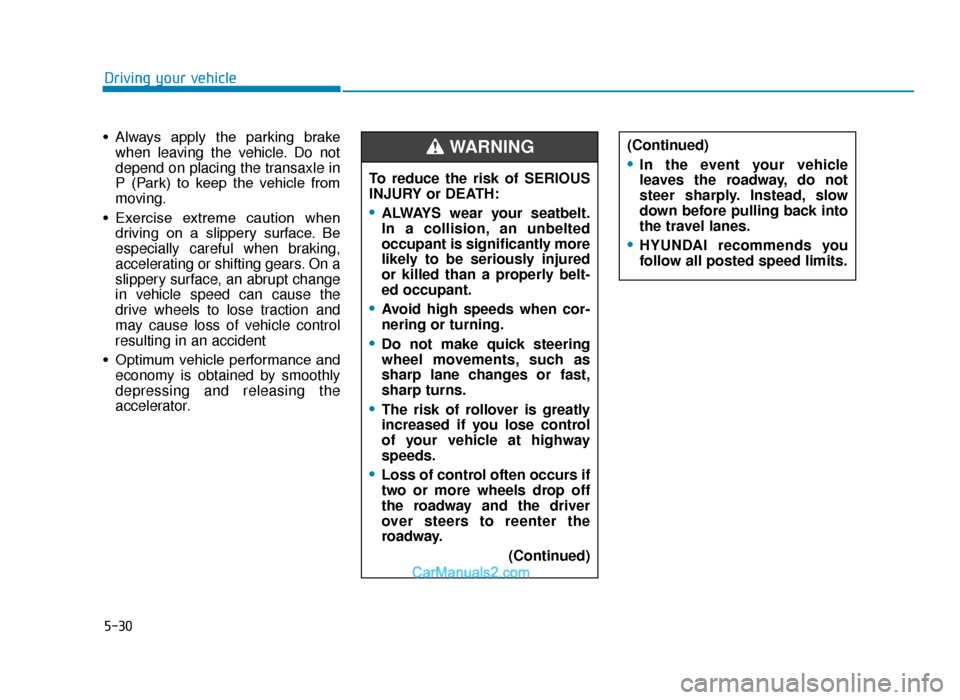
5-30
Driving your vehicle
• Always apply the parking brake when leaving the vehicle. Do not
depend on placing the transaxle in
P (Park) to keep the vehicle from
moving.
• Exercise extreme caution when driving on a slippery surface. Be
especially careful when braking,
accelerating or shifting gears. On a
slippery surface, an abrupt change
in vehicle speed can cause the
drive wheels to lose traction and
may cause loss of vehicle control
resulting in an accident
• Optimum vehicle performance and economy is obtained by smoothly
depressing and releasing the
accelerator. (Continued)
•In the event your vehicle
leaves the roadway, do not
steer sharply. Instead, slow
down before pulling back into
the travel lanes.
•HYUNDAI recommends you
follow all posted speed limits.
To reduce the risk of SERIOUS
INJURY or DEATH:
•ALWAYS wear your seatbelt.
In a collision, an unbelted
occupant is significantly more
likely to be seriously injured
or killed than a properly belt-
ed occupant.
•Avoid high speeds when cor-
nering or turning.
•Do not make quick steering
wheel movements, such as
sharp lane changes or fast,
sharp turns.
•The risk of rollover is greatly
increased if you lose control
of your vehicle at highway
speeds.
•Loss of control often occurs if
two or more wheels drop off
the roadway and the driver
over steers to reenter the
roadway.
(Continued)
WARNING
TLe UK 5.qxp 5/10/2018 12:20 PM Page 30
Page 355 of 685
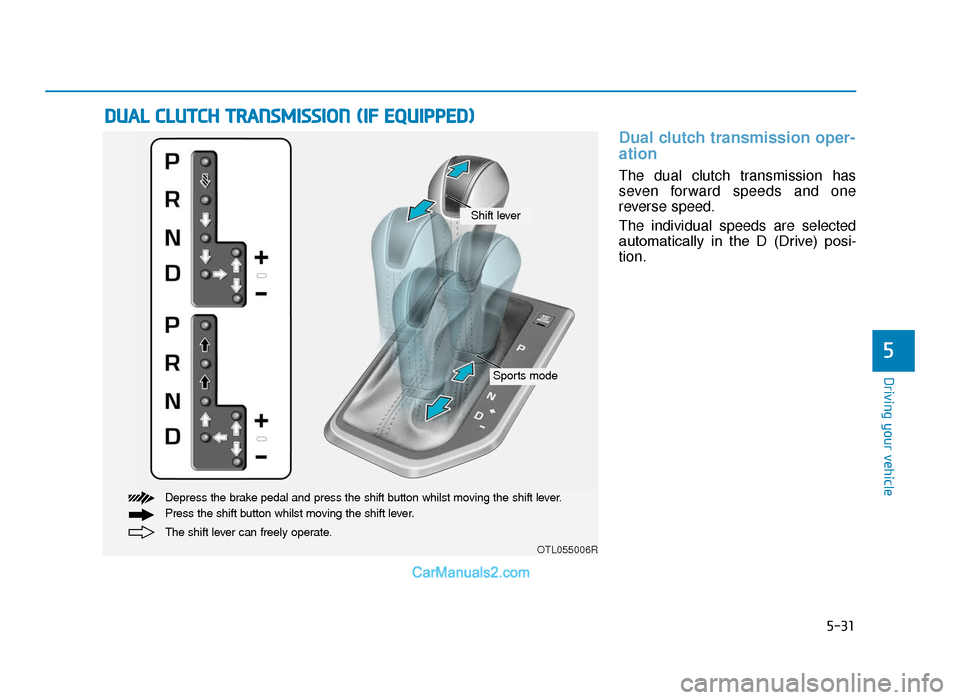
5-31
Driving your vehicle
5
Dual clutch transmission oper-
ation
The dual clutch transmission has
seven forward speeds and one
reverse speed.
The individual speeds are selected
automatically in the D (Drive) posi-
tion.
DUAL CLUTCH TRANSMISSION (IF EQUIPPED)
OTL055006R
The shift lever can freely operate. Depress the brake pedal and press the shift button whilst moving the shift lever.
Press the shift button whilst moving the shift lever.
Sports mode
Shift lever
TLe UK 5.qxp 5/10/2018 12:20 PM Page 31
Page 356 of 685
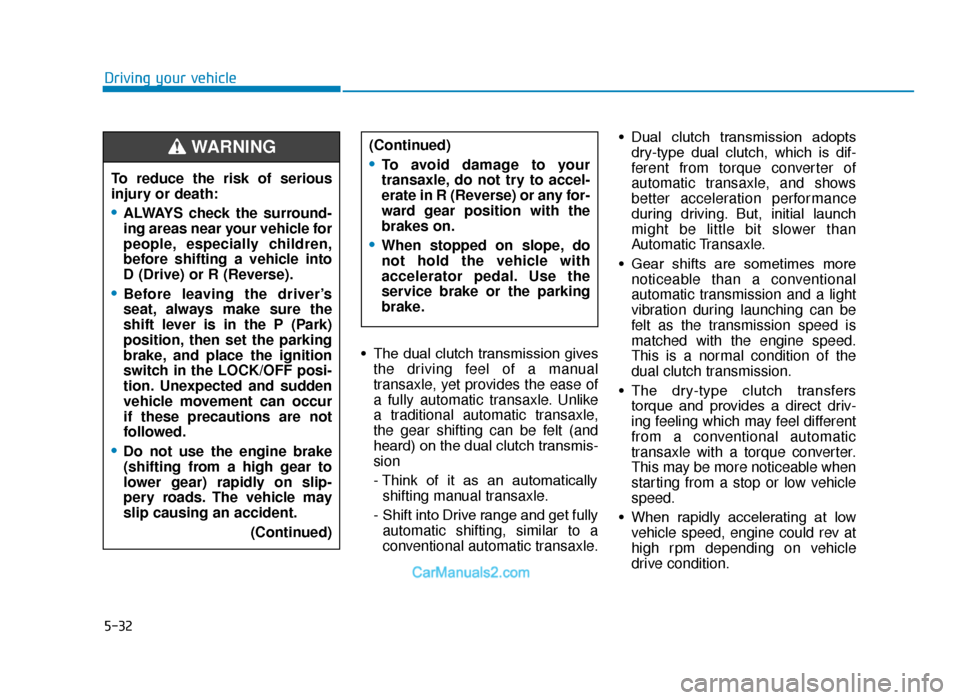
5-32
Driving your vehicle• The dual clutch transmission givesthe driving feel of a manual
transaxle, yet provides the ease of
a fully automatic transaxle. Unlike
a traditional automatic transaxle,
the gear shifting can be felt (and
heard) on the dual clutch transmis-
sion
- Think of it as an automaticallyshifting manual transaxle.
- Shift into Drive range and get fully automatic shifting, similar to a
conventional automatic transaxle. • Dual clutch transmission adopts
dry-type dual clutch, which is dif-
ferent from torque converter of
automatic transaxle, and shows
better acceleration performance
during driving. But, initial launch
might be little bit slower than
Automatic Transaxle.
• Gear shifts are sometimes more noticeable than a conventional
automatic transmission and a light
vibration during launching can be
felt as the transmission speed is
matched with the engine speed.
This is a normal condition of the
dual clutch transmission.
• The dry-type clutch transfers torque and provides a direct driv-
ing feeling which may feel different
from a conventional automatic
transaxle with a torque converter.
This may be more noticeable when
starting from a stop or low vehicle
speed.
• When rapidly accelerating at low vehicle speed, engine could rev at
high rpm depending on vehicle
drive condition.
To reduce the risk of serious
injury or death:
•ALWAYS check the surround-
ing areas near your vehicle for
people, especially children,
before shifting a vehicle into
D (Drive) or R (Reverse).
•Before leaving the driver’s
seat, always make sure the
shift lever is in the P (Park)
position, then set the parking
brake, and place the ignition
switch in the LOCK/OFF posi-
tion. Unexpected and sudden
vehicle movement can occur
if these precautions are not
followed.
•Do not use the engine brake
(shifting from a high gear to
lower gear) rapidly on slip-
pery roads. The vehicle may
slip causing an accident.
(Continued)
(Continued)
•To avoid damage to your
transaxle, do not try to accel-
erate in R (Reverse) or any for-
ward gear position with the
brakes on.
•When stopped on slope, do
not hold the vehicle with
accelerator pedal. Use the
service brake or the parking
brake.
WARNING
TLe UK 5.qxp 5/10/2018 12:20 PM Page 32
Page 357 of 685
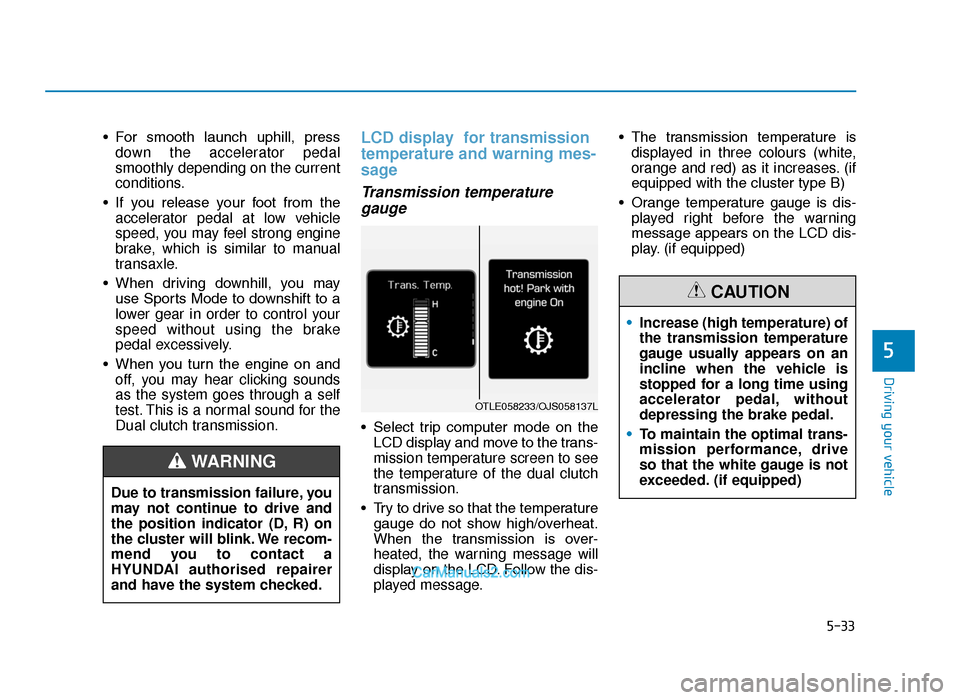
5-33
Driving your vehicle
5
• For smooth launch uphill, pressdown the accelerator pedal
smoothly depending on the current
conditions.
• If you release your foot from the accelerator pedal at low vehicle
speed, you may feel strong engine
brake, which is similar to manual
transaxle.
• When driving downhill, you may use Sports Mode to downshift to a
lower gear in order to control your
speed without using the brake
pedal excessively.
• When you turn the engine on and off, you may hear clicking sounds
as the system goes through a self
test. This is a normal sound for the
Dual clutch transmission.LCD display for transmission
temperature and warning mes-
sage
Transmission temperaturegauge
• Select trip computer mode on the
LCD display and move to the trans-
mission temperature screen to see
the temperature of the dual clutch
transmission.
• Try to drive so that the temperature gauge do not show high/overheat.
When the transmission is over-
heated, the warning message will
display on the LCD. Follow the dis-
played message. • The transmission temperature is
displayed in three colours (white,
orange and red) as it increases. (if
equipped with the cluster type B)
• Orange temperature gauge is dis- played right before the warning
message appears on the LCD dis-
play. (if equipped)
Due to transmission failure, you
may not continue to drive and
the position indicator (D, R) on
the cluster will blink. We recom-
mend you to contact a
HYUNDAI authorised repairer
and have the system checked.
WARNING
OTLE058233/OJS058137L
• Increase (high temperature) of
the transmission temperature
gauge usually appears on an
incline when the vehicle is
stopped for a long time using
accelerator pedal, without
depressing the brake pedal.
• To maintain the optimal trans-
mission performance, drive
so that the white gauge is not
exceeded. (if equipped)
CAUTION
TLe UK 5.qxp 5/10/2018 12:20 PM Page 33
Page 358 of 685
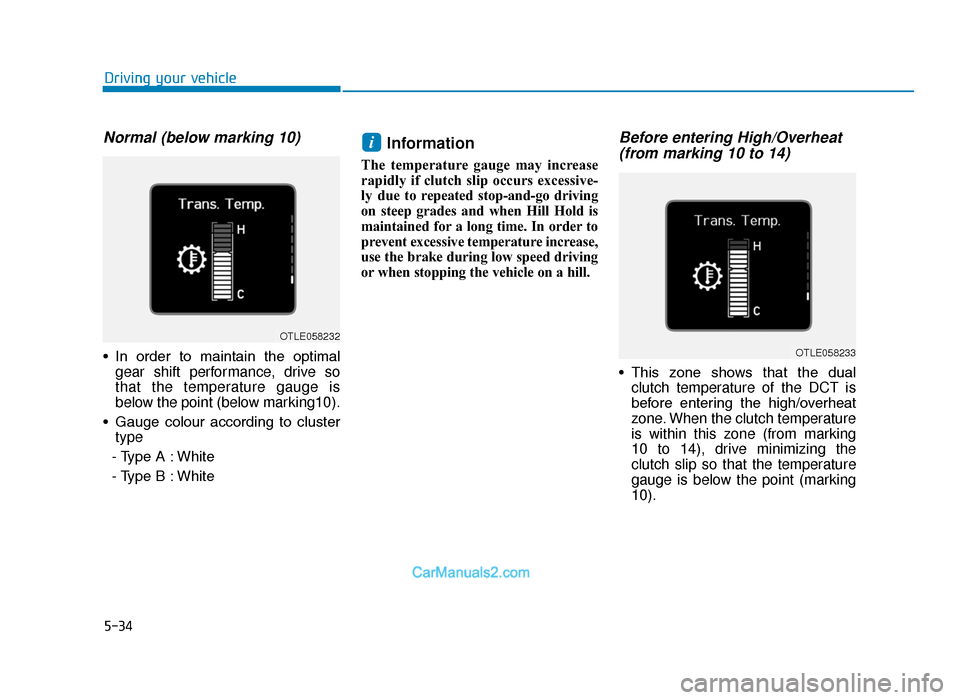
5-34
Normal (below marking 10)
• In order to maintain the optimalgear shift performance, drive so
that the temperature gauge is
below the point (below marking10).
• Gauge colour according to cluster type
- Type A : White
- Type B : White
Information
The temperature gauge may increase
rapidly if clutch slip occurs excessive-
ly due to repeated stop-and-go driving
on steep grades and when Hill Hold is
maintained for a long time. In order to
prevent excessive temperature increase,
use the brake during low speed driving
or when stopping the vehicle on a hill.
Before entering High/Overheat (from marking 10 to 14)
• This zone shows that the dual
clutch temperature of the DCT is
before entering the high/overheat
zone. When the clutch temperature
is within this zone (from marking
10 to 14), drive minimizing the
clutch slip so that the temperature
gauge is below the point (marking
10).
i
Driving your vehicle
OTLE058232
OTLE058233
TLe UK 5.qxp 5/10/2018 12:20 PM Page 34
Page 359 of 685
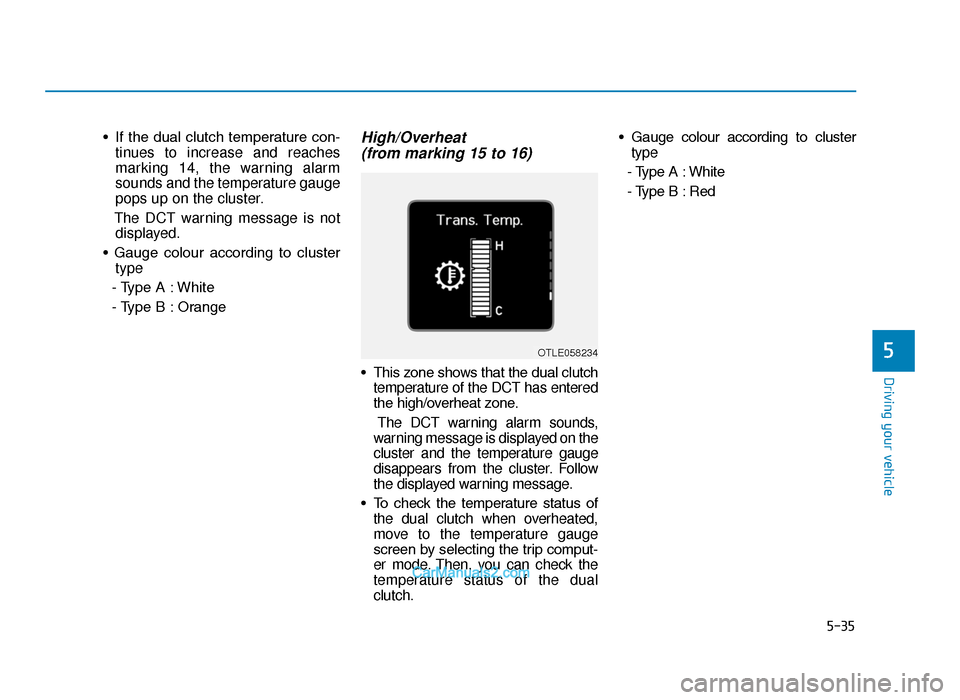
5-35
Driving your vehicle
• If the dual clutch temperature con-tinues to increase and reaches
marking 14, the warning alarm
sounds and the temperature gauge
pops up on the cluster.
The DCT warning message is not displayed.
• Gauge colour according to cluster type
- Type A : White
- Type B : OrangeHigh/Overheat (from marking 15 to 16)
• This zone shows that the dual clutch
temperature of the DCT has entered
the high/overheat zone.
The DCT warning alarm sounds,
warning message is displayed on the
cluster and the temperature gauge
disappears from the cluster. Follow
the displayed warning message.
• To check the temperature status of the dual clutch when overheated,
move to the temperature gauge
screen by selecting the trip comput-
er mode. Then, you can check the
temperature status of the dual
clutch. • Gauge colour according to cluster
type
- Type A : White
- Type B : Red
5OTLE058234
TLe UK 5.qxp 5/10/2018 12:20 PM Page 35
Page 360 of 685
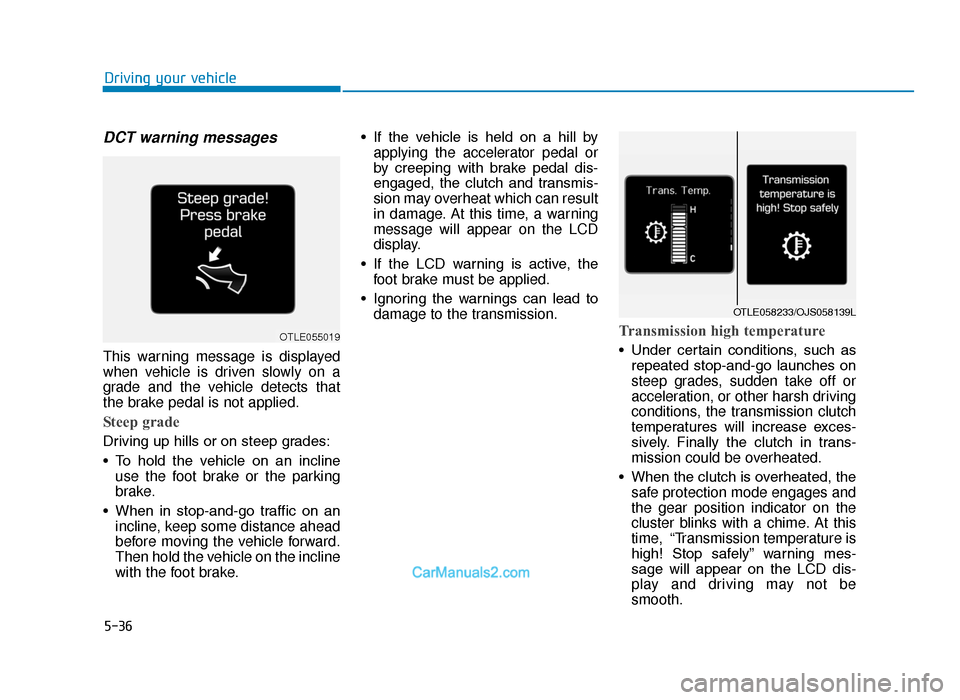
5-36
DCT warning messages
This warning message is displayed
when vehicle is driven slowly on a
grade and the vehicle detects that
the brake pedal is not applied.
Steep grade
Driving up hills or on steep grades:
• To hold the vehicle on an inclineuse the foot brake or the parking
brake.
• When in stop-and-go traffic on an incline, keep some distance ahead
before moving the vehicle forward.
Then hold the vehicle on the incline
with the foot brake. • If the vehicle is held on a hill by
applying the accelerator pedal or
by creeping with brake pedal dis-
engaged, the clutch and transmis-
sion may overheat which can result
in damage. At this time, a warning
message will appear on the LCD
display.
• If the LCD warning is active, the foot brake must be applied.
• Ignoring the warnings can lead to damage to the transmission.
Transmission high temperature
• Under certain conditions, such asrepeated stop-and-go launches on
steep grades, sudden take off or
acceleration, or other harsh driving
conditions, the transmission clutch
temperatures will increase exces-
sively. Finally the clutch in trans-
mission could be overheated.
• When the clutch is overheated, the safe protection mode engages and
the gear position indicator on the
cluster blinks with a chime. At this
time, “Transmission temperature is
high! Stop safely” warning mes-
sage will appear on the LCD dis-
play and driving may not be
smooth.
Driving your vehicle
OTLE055019
OTLE058233/OJS058139L
TLe UK 5.qxp 5/10/2018 12:20 PM Page 36